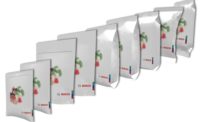Balancing the demand for different pack sizes with a range of production considerations is no easy feat, but form-fill-seal machines can make the job a little easier.
In addition to flexibility in packaging, vertical form-fill-seal machines are ideal for placement in tight plant layouts, thanks to their small foot prints and included capabilities for weighing and metal detection.
Edward Smagarinsky, group product manager (mogul), tna solutions, recently spoke to Candy Industry about how form-fill-seal machines can meet the varying needs of confectionery manufacturers.
CI: Why are form-fill-seal machines ideal for packaging confectionery products?
ES: In keeping with changing consumption trends, the way confectionery is packaged is evolving — with a shift from larger share-size bags to single portion packets. In fact, pack sizes ranging from single-serve portions to multi-pack options are now commonplace on a single production line. It is therefore crucial that packaging equipment offers the flexibility to handle different film sizes required, as well as switch between different formats quickly and easily to keep up with increasing demand. All this while keeping packaging and product waste to a minimum and reducing operational and maintenance costs.
The flexibility of form-fill-seal machines makes them ideal for packaging confectionery products. Now, more than ever, manufacturers need the option to quickly scale up or down production to meet sudden fluctuations in consumer demand and ensure their lines are future-proofed. Take, for example, modular systems, which enable production output to be easily modified or extended with additional units and allow multiple products to be processed on a single line — thanks to fast changeover times and minimal clean-down requirements.
CI: What should manufacturers look for in a form-fill-seal machine?
ES: In such a highly price-sensitive market, every penny counts. And that’s why manufacturers continually look for opportunities to maximize efficiencies, minimize waste and ensure a smaller machine footprint. This is where vertical form, fill and seal (VFFS) technology can offer numerous benefits, as it can increase productivity without investing more time, energy or manpower. In confectionery manufacturing facilities, where space comes at a premium, the vertical configuration enables a smaller footprint, freeing up space to incorporate multiple packaging lines. Plus, marketing-leading VFFS technology can also reduce waste to as low as 0.5 percent — helping to boost manufacturers’ green credentials.
CI: How does speed play into this?
ES: Speed has historically played a crucial part in packaging, with producers striving to achieve the highest throughput speeds possible for a competitive edge. Although we can’t deny that high performance is still important, manufacturers are starting to look at packaging lines much more holistically — making smaller, incremental improvements to increase efficiencies instead. For instance, making sure equipment is easy to clean to minimize production downtime, optimizing product transfer or implementing a more automated approach can make a significant difference in terms of throughput rates.
VFFS packaging systems have evolved to support a wider range of confectionery packaging options at even higher speeds. The fact remains, though, that bagging speed can be significantly impacted with size and format changes, since components like formers, film rolls and jaws system, must be replaced during production cycles.
CI: How does the ability to work with different pouch sizes and materials play into this?
ES: Switching between different pouch sizes can invariably impact production speed. Bigger share packs — which have seen a surge in demand in recent months — usually take longer to fill which, can slow down throughput, and vice versa. Manufacturers must therefore consider the capacity of the line as a whole to be able to cope with different fill and bagging requirements in the most efficient way possible. Investing in equipment with production flexibility, as well as processing and packaging equipment that can complement each other’s output, is the key to success.
A key consideration when switching to smaller bag formats is the jaw system — it must be able to effectively handle the required packet size, including the film width, length, and type. Market-leading VFFS systems offer a wide range of jaw configurations, such as single, double, rotary double, rotary triple and rotary flat to give manufacturers maximum flexibility to handle varying bag sizes and formats. tna’s rotary triple jaw, for example, tends to be suitable for smaller pack sizes and can achieve throughputs in the region of 250 bpm.
CI: How can form-fill-seal machines help manufacturers with quality control (i.e. weighing and metal detection)?
ES: When it comes to quality control, implementing a fully integrated solution, where the entire unit works as one and is operated from a single point of control, shouldn’t be underestimated. Making it easier to integrate auxiliary equipment, such as date coders, metal detectors and stripper tube closures, the latest form, fill and seal equipment can be adapted to meet manufacturers’ increasingly stringent quality control requirements.
Such an approach is particularly important with the current popularity of mixed confectionery packs containing components of varying size, weight and finish, where it can be difficult to achieve an even distribution of different sweet types, as well as an equal pack weight every time. Multi-head weighing solutions are one way in which manufacturers can ensure precisely measured bags of mixed confectionery, to not only help meet consumer expectations but also help enhance ROI through reduced product waste.
CI: What other advances has tna made in form-fill-seal equipment lately?
ES: Over recent months, our key priority has been helping customers through this challenging time via the development of our aftermarket support service. The impact on the food manufacturing industry has been significant, with many new equipment orders disrupted and a growing focus on reducing capital expenditure. The processing and packaging industry therefore has a role to play in helping customers to get the most out of their machines, to help meet fluctuating consumer demands and reducing operational efficiencies as much as possible. As such, advances in “smart” technology are proving crucial to manufacturers, by ensuring they get the right technical support at the right time — whether it is remotely or in-person.








